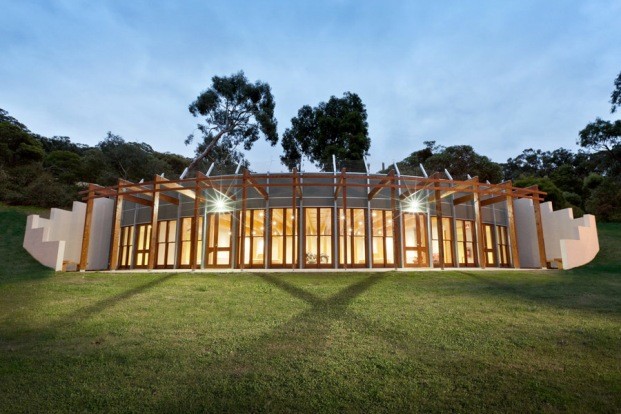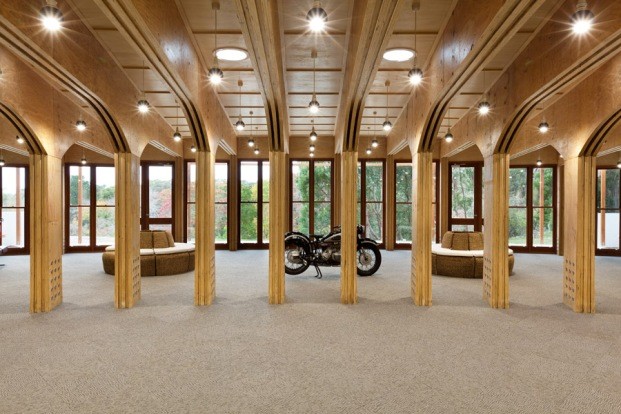Paul Haar is a self employed architect who enjoys the flexibility of balancing family life and a small farm with major projects such as the award winning Candlebark School Library.
Where do you currently work?
I'm self-employed as a sole-practising architect based in Melbourne.
What does your standard workday involve?
I probably have nothing that resembles a standard workday. As a sole practitioner, I’ll find large chunks of my day focused on any one of a broad range of tasks – from engagement in long meetings with clients and other consultants, to writing reports and birthing schematic designs; from preparing construction drawings and specifications, to inspecting and administering works on site. And then there’s the downtime dealing with business administration, IT and other matters.
What tools and software do you work with?
For my drawing work I use ArchiCAD. Troubleshooting and keeping up with advances in CAD are not my forte, and I’ve found ArchiCAD to be reasonably intuitive. But the licence to use ArchiCAD and access to its upgrades are extremely expensive for a small practitioner like me.
What is your biggest daily challenge?
Finding enough time to do all the things I aim to work-wise, and balancing that time to also meet commitments at home. Working from home has its challenges, but it also has its advantages professionally and domestically.
What were your previous jobs and roles?
-
1987 - 1992 Project architect and construction manager/facilitator for community based housing projects on Moa and Palm Islands North Queensland.
-
1985 - 1986 Contract architect with Australian Construction Services.
-
Housing and public buildings for Aboriginal communities in Victoria and NSW.
-
Tutor in architectural design (University of Melbourne).
-
1984 Project architect and construction manager/facilitator for self-help housing projects in Katherine and Arnhem Land NT.
-
1983 Contract architect with Daryl Jackson Pty. Ltd.
-
Facilitator for small building works at Lake Tyers Aboriginal Trust Vic.
-
1981-1982 Consultant to CERES Brunswick - master-planning and low-energy house.
-
Consultant to Burnley Horticultural College and Victorian State Schools' Nursery,
re commercial greenhouse energy management.
-
1980 - Tutor in architectural design (University of Melbourne).
-
Research assistant in computer-based systems development for simulation of thermal performance of buildings (University of Melbourne).
-
1978 - Student architect with Special Schools Section of Public Works Department Vic.

Candlebark School Library
What training/education did you need for your job?
I studied at Melbourne University and graduated with a Bachelor of Architecture back in 1981. Then preparing to register as an architect required some further study in professional practice. And my ongoing career development requires lots of reading, participation in seminars and workshops, and a general hunger for enquiry.
What do you like best about your job?
Obviously I love the creative pursuit attached to architecture. Since my uni days in the late 1970s, I’ve held a passion for and focus on building environmentally and socially sustainable futures. Back then it was fringe hippy stuff. I’ve enjoyed engaging professionally over 35 years in a sphere where this objective has now been mainstreamed.
I feel we’re now at the point where we needn’t speak about green design anymore. Sustainability should now be intrinsic and basic to good (respectful and beautiful) architectural design.
Because I work as a sole practitioner, I have the flexibility to divide my time between architectural work, my family and other pursuits of interest. So I can be around for our boys after school, and spend a sunny day each week picking fruit or pruning trees in our small farm orchard. I can take on odd pro-bono work, or duck out of the office to turn the compost at our boys’ school kitchen-garden. These deviations would be more problematic were I accountable to or responsible for a team office. But I feel they give me broader life context to inform my architectural engagements, and they get me off my office chair to flex old bones.
What is your biggest frustration in your job?
Whilst odd things get me stirred up from time to time, there's not much that frustrates me on a chronic basis. Nonetheless I would like to see more technical rigour and ethical clarity in the thinking that informs the promotion, measurement and rating of sustainable design - green building products and systems.
What are you most proud of and why?
If I have reason to be proud of a project, I’m then also very mindful that my design would be no more than that (an idea) were it not for the inspiration, faith and courage of my client, as well as the craftsmanship and hard work of the tradespeople who have brought the design to life. If you take the Candlebark School Library, I was in deep admiration of the carpenter/foreman on the job (now a great friend) and of course the client John Marsden. So the greatest pride for me is that which I can share.

Candlebark School Library
What's been your biggest career challenge?
Soon after graduating, so through the 1980s and early 1990s, I found myself in rural and remote parts of Australia living and working with indigenous Australians whose aim it was to design and build homes for themselves using materials from the bush and construction methods suited to the local unskilled workforce. My challenge was to guide these self-help housing projects through both design and construction phases. I found that a real challenge, but also enormously satisfying. To read more, click here.
What is the biggest challenge facing your business?
Through the years I’ve been in practice, the cost of building construction, and certainly of custom designed housing, has escalated well in excess of the Consumer Price Index (CPI). 30 years ago most Australians were unaware of the value that architects can bring to home making. Today glossy consumer magazines, lifestyle shows and Grand Designs have cultivated a popular taste for architectural design. But more than ever it remains unaffordable to the general populace.
I suspect that industrialised building systems will move into some of the project space currently occupying small architects like myself. These systems are based on high-capital low-labour high-tech inputs both in design and construction. By definition they favour big and global business enterprise over small local products and services. They represent a new direction in building procurement already well advanced in Europe and parts of Asia. And I must say this concerns me, not only with regard to my profession’s relevance in it all, but also the associated environmental and social impacts.
I’ve always been very keen to provide a good personalised architectural service to clients of all socio-economic backgrounds, not only to people with grand dreams and big budgets. I actually prefer clients with more modest aspirations and means, who favour quality over quantity. My biggest challenge is to remain equipped to provide architectural processes and solutions that are affordable and satisfying for my broad client base, but also innovative and thoughtful at a broader level, responding to a new age of planetary limits.
Contact details?
Am old fashioned – have only ….
[email protected]
0409 011 335

